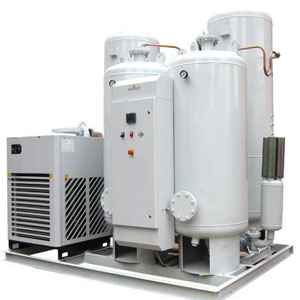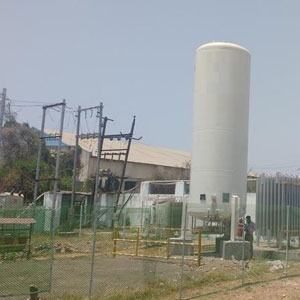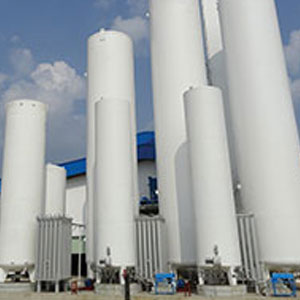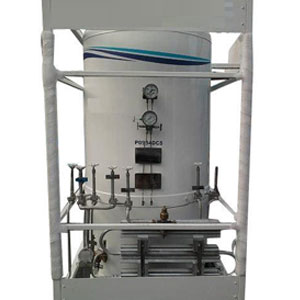Pipeline System
Medical gas supply systems in hospitals and other healthcare facilities are utilized to supply specialized gases and gas mixtures to various parts of the facility. Products handled by such systems typically include:
Oxygen
Medical air
Nitrous oxide
Nitrogen
Carbon dioxide
Medical vacuum
Waste Anaesthetic Gas Disposal (US) or Anaesthetic Gas Scavenging System (ISO)
Source equipment systems are generally required to be monitored by alarm systems at the point of supply for abnormal (high or low) gas pressure in areas such as general ward, operating theatres, ICU/ITU/CCU/NICU, recovery, major treatment rooms, etc. Equipment is connected to the medical gas pipeline system via Station Outlets (US) or Terminal Units (ISO).
Medical gas systems are commonly color coded to identify their contents, but as coding systems and requirements (such as those for bottled gas) vary by jurisdiction, the text or labeling is the most reliable guide to the contents. Emergency shut-off valves, or zone valves, are often installed in order to stop gas flowing to an area in the event of fire or substantial leak, as well as for service. Valves may be positioned at the entrance to departments, with access provided via emergency pull-out windows.
Oxygen
Oxygen may be used for patients requiring supplemental oxygen via mask. Usually accomplished by a large storage system of liquid oxygen at the hospital which is evaporated into a concentrated oxygen supply, pressures are usually around 345-380 kPa (50-55 psi), or in the UK and Europe, 4-5 bar (approximately 58-72 psi).This arrangement is described as a vacuum insulated evaporator (VIE) or bulk tank. In small medical centers with a low patient capacity, oxygen is usually supplied by a manifold of multiple high-pressure cylinders. In areas where a bulk system or high-pressure cylinder manifold is not suitable, oxygen may be supplied by an oxygen concentrator. However, on site production of oxygen is still a relatively new technology.
Medical air
Medical air is compressed air supplied by a special air compressor, through a dryer (in order to maintain correct dewpoint levels), and distributed to patient care areas. In smaller facilities, medical air may also be supplied via high-pressure cylinders. Pressures are maintained around 345-380 kPa (50-55 psi).
Nitrous oxide
Nitrous oxide is supplied to various surgical suites for its anaesthetic functions during pre-operative procedures. It is delivered to the hospital in high-pressure cylinders and supplied through the Medical Gas system. Some bulk systems exist, but are no longer installed due to environmental concerns and overall reduced consumption of Nitrous oxide. System pressures are around 345 kPa (50 psi), 4 bar UK.
Nitrogen
Nitrogen is typically used to power pneumatic surgical equipment during various procedures, and is supplied by high-pressure cylinders. Pressures range around 1.2 MPa (175 psi) to various locations.
Instrument air/Surgical air
Like Nitrogen, Instrument air is used to power surgical equipment. However, it is generated on site by an air compressor (similar to a Medical air compressor) rather than high-pressure cylinders. Early air compressors could not offer the purity required to drive surgical equipment. However, this has changed and instrument air is becoming a popular alternative to Nitrogen. As with Nitrogen, pressures range around 1.2 MPa (175 psi). UK systems are supplied at 11 bar to the local area and regulated down to 7-8 bar at point of use.
Carbon dioxide
Typically used for insufflation during surgery, and also used in laser surgeries. System pressures are maintained at about 345 kPa (50 psi), UK 4 bar. It is also used for certain respiratory disorders.It contains 5 percent.
Medical vacuum
Medical vacuum in a hospital supports suction equipment and evacuation procedures, supplied by vacuum pump systems exhausting to the atmosphere. Vacuum will fluctuate across the pipeline, but is generally maintained around -75 kPa (-22 inHg), (450mmHg UK).
WAGD/AGSS
Waste Anaesthetic Gas Disposal (WAGD), or Anaesthetic Gas Scavenging System (AGSS), is used in hospital anaesthesia evacuation procedures. Although it is similar to a medical vacuum system, some building codes require anaesthetic gases to be scavenged separately. Scavenging systems do not need to be as powerful as medical vacuum systems, and can be maintained around -50 to -65 kPa (-15 to -19 inHg).
Medical gas mixtures
There are many gas mixtures used for clinical and medical applications. They are often used for patient diagnostics such as lung function testing or blood gas analysis. Test gases are also used to calibrate and maintain medical devices used for the delivery of anaesthetic gases. In laboratories, culture growth applications include controlled aerobic or anaerobic incubator atmospheres for biological cell culture or tissue growth. Controlled aerobic conditions are created using mixtures rich in oxygen and anaerobic conditions are created using mixtures rich in hydrogen or carbon dioxide. Supply pressure is 4 bar.
Two common medical gas mixtures are Entonox and Heliox.

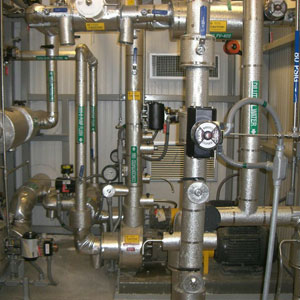
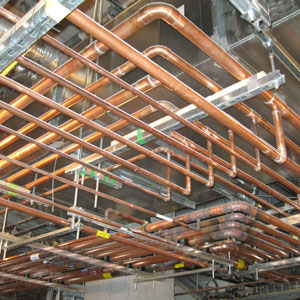
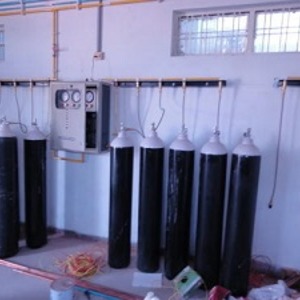
Onsite Plants
An air separation plant separates atmospheric air into its primary components, typically nitrogen and oxygen, and sometimes also argonand other rare inert gases.
The most common method for air separation is fractional distillation. Cryogenic air separation units (ASUs) are built to provide nitrogen or oxygen and often co-produce argon. Other methods such as membrane, pressure swing adsorption (PSA) and vacuum pressure swing adsorption (VPSA) are commercially used to separate a single component from ordinary air. High purity oxygen, nitrogen, and argon used for semiconductor device fabrication requires cryogenic distillation. Similarly, the only viable source of the rare gases neon, krypton, and xenon is the distillation of air using at least two distillation columns.
Cryogenic distillation process
The cryogenic separation process requires a very tight integration of heat exchangers and separation columns to obtain a good efficiency and all the energy for refrigeration is provided by the compression of the air at the inlet of the unit.Pure gases can be separated from air by first cooling it until it liquefies, then selectively distilling the components at their various boiling temperatures. The process can produce high purity gases but is energy-intensive.
To achieve the low distillation temperatures an air separation unit requires a refrigeration cycle that operates by means of the Joule–Thomson effect, and the cold equipment has to be kept within an insulated enclosure (commonly called a "cold box"). The cooling of the gases requires a large amount of energy to make this refrigeration cycle work and is delivered by an air compressor. Modern ASUs use expansion turbines for cooling; the output of the expander helps drive the air compressor, for improved efficiency. The process consists of the following main steps:
Before compression the air is pre-filtered of dust.
Air is compressed where the final delivery pressure is determined by recoveries and the fluid state (gas or liquid) of the products. Typical pressures range between 5 and 10 bar gauge. The air stream may also be compressed to different pressures to enhance the efficiency of the ASU. During compression water is condensed out in inter-stage coolers.
The process air is generally passed through a molecular sieve bed, which removes any remaining water vapour, as well as carbon dioxide, which would freeze and plug the cryogenic equipment. Molecular sieves are often designed to remove any gaseous hydrocarbons from the air, since these can be a problem in the subsequent air distillation that could lead to explosions. The molecular sieves bed must be regenerated. This is done by installing multiple units operating in alternating mode and using the dry co-produced waste gas to desorb the water.
Process air is passed through an integrated heat exchanger (usually a plate fin heat exchanger) and cooled against product (and waste) cryogenic streams. Part of the air liquefies to form a liquid that is enriched in oxygen. The remaining gas is richer in nitrogen and is distilled to almost pure nitrogen (typically < 1ppm) in a high pressure (HP) distillation column. The condenser of this column requires refrigeration which is obtained from expanding the more oxygen rich stream further across a valve or through an Expander, (a reverse compressor).
Alternatively the condenser may be cooled by interchanging heat with a reboiler in a low pressure (LP) ditillation column (operating at 1.2-1.3 bar abs.) when the ASU is producing pure oxygen. To minimize the compression cost the combined condenser/reboiler of the HP/LP columns must operate with a temperature difference of only 1-2 K, requiring plate fin brazed aluminium heat exchangers. Typical oxygen purities range in from 97.5% to 99.5% and influences the maximum recovery of oxygen. The refrigeration required for producing liquid products is obtained using the Joule–Thomson effect in an expander which feeds compressed air directly to the low pressure column. Hence, a certain part of the air is not to be separated and must leave the low pressure column as a waste stream from its upper section.
Because the boiling point of argon (87.3 K at standard conditions) lies between that of oxygen (90.2 K) and nitrogen (77.4 K), argon builds up in the lower section of the low pressure column. When argon is produced, a vapor side draw is taken from the low pressure column where the argon concentration is highest. It is sent to another column rectifying the argon to the desired purity from which liquid is returned to the same location in the LP column. Use of modern structured packings which have very low pressure drops enable argon with less than 1 ppm impurities. Though argon is present in less to 1% of the incoming, the air argon column requires a significant amount of energy due to the high reflux ratio required (about 30) in the argon column. Cooling of the argon column can be supplied from cold expanded rich liquid or by liquid nitrogen.
Finally the products produced in gas form are warmed against the incoming air to ambient temperatures. This requires a carefully crafted heat integration that must allow for robustness against disturbances (due to switch over of the molecular sieve beds). It may also require additional external refrigeration during start-up.
The separated products are sometimes supplied by pipeline to large industrial users near the production plant. Long distance transportation of products is by shipping liquid product for large quantities or as dewar flasks or gas cylinders for small quantities.
